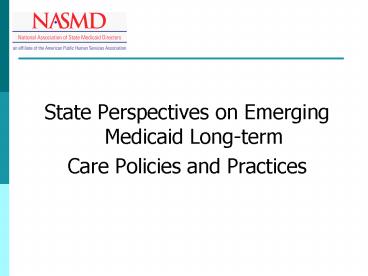State Perspectives on Emerging Medicaid Longterm PowerPoint PPT Presentation
1 / 33
Title: State Perspectives on Emerging Medicaid Longterm
1
- State Perspectives on Emerging Medicaid Long-term
- Care Policies and Practices
2
In a perfect world
3
Survey
- Surveyed developed by the Chronic Care TAG and
Eligibility TAG - Reviewing two things impact on the DRA on LTC
and major activities in states on LTC - July 2007
- 43 states and 2 territories completed the survey
4
DRA Changes
- Eligibility
- Long-Term Care Partnership Programs
- Family Opportunity Act
- Money Follows the Person Demonstration
- HCBS-State Option
- Personal Care Services Cash and Counseling
5
Demographics
- Medicaid accounts for 40 percent of all Long-Term
Care services - Total Medicaid LTC services in FY06 were nearly
100 billion - Medicaid Nursing Home expenditures in FY06 were
47.7 billion - Spending on community-based LTC services rose to
39 percent while 61 percent was on institutional
care
6
Trend Aging Population
7
HCBS Services and Medicaid
- Individuals under 65 are more likely then those
over 65 to use HCBS - Expenditures for community-based LTC continue to
expand more rapidly than institutional
expenditures
8
Finding 1
- Eligibility for Long-Term Care services under the
Deficit Reduction Act was tightened and states
have responded.
9
Changes states made
- Changing the look-back period
- Changes in annuities
- Income-first rules
- Home-equity limits
- Changing the start date of the penalty period
- Changing the requirement on partial months of
ineligibility
- Changes to accumulate multiple transfers in one
month - Changes regarding purchase of promissory notes,
loans, mortgages - Changing requirements regarding the purchase of
life estates - Changing the hardship waivers
10
Finding 2
- Most states have not used the Family Opportunity
Act to extend Medicaid coverage to children with
disabilities in families with higher incomes
11
Family Opportunity Act
- 3 states plan to make this option available
- 4 states still considering it
12
Finding 3
- States are using their Money Follows the Person
Grant dollars in several ways - Goal is to create a incentive for states to
rebalance their long-term care services programs - 31 states, 1.4 billion in funding
13
Finding 4
- To date, most states are not opting to switch to
the HCBS State Plan Amendment option
14
HCBS Waiver v. Plan
- Waiver
- Includes level of care requirements
- Must be cost-neutral
- Can waiver income limits and eligibility criteria
- State Plan
- No level of care requirement
- Does not have to be cost-neutral
- Cannot expand eligibility, income can only go to
150 FPL
15
Services States Plan to Provide
- Adult day health
- Attendant care
- Companion care
- Emergency Alert system
- Habilitation
- Home-delivered meals
- Home health services/home health aide
- Home health services/RN and LPN
- Home modification
- Respite
- Assertive community treatment
- Partial Hospitalization
- Psychosocial Rehab
16
States Reasons for not moving to SPA
- Lack of federal guidance
- Lack of ability to alter services among
populations - Increased state costs
- Financial eligibility too restrictive
- Financial constraints
17
Finding 5
- States are initiating efforts to transition
individuals out of institutions
18
State Innovations
- One-stop resource centers and websites
- Pre-admissions screening tools
- Relocation case management services
- Approving spouses as paid caregivers
- Paying for transitional needs under a home
again program - Reviewing all nursing home admissions at 45 days
- Providing an establishment fundfurnishings,
lights, water
19
Finding 6
- States are using managed care for individuals
with disabilities - 14 states now have a managed care program for
individuals with disabilities
20
Finding 7
- Fewer than 10 states plan to submit a SPA for
Personal Care Services (Cash and Counseling)
programs - Survey conducted prior to the release of the SMD
providing states with additional guidance
21
Benefits of Self-Directed Services
- Allows participants flexibility and authority in
hiring, training, and selection of providers - Provides the participants with choices
- Promotes independence
- Allows ultimate flexibility in securing
non-medical services
22
Finding 8
- Special Needs Plans are in place in at least 21
states, but states have concerns about the
coordination between Medicare and Medicaid.
23
Special Needs Plans State Concerns
- Wide variation among plans
- Lack of experience dealing with developmentally
delayed clients/mental health clients - Lack of services in rural areas
- Poor coordination among Medicare and Medicaid
24
Finding 9
- Long-Term Care reform in the states continues to
encourage home- and community-based living
25
Long-Term Care Reform
- Long-Term Care media awareness campaigns
- Nursing Home Reform
26
Finding 10
- States are using Care Coordination to improve and
integrate care
27
Care Coordination
- 20 statesa dozen more reported putting in place
- Helps to develop plans of care and ensure
individuals receive services - Coordinate access to care, social and community
supports - Nurses and medical social workers
28
Finding 11
- More states are using Disease Management to help
manage chronic conditions
29
Disease Management
- Diabetes, obesity, congestive heart failure, and
asthma - Help patients to adhere to medication regimens,
receive regular monitoring, and develop healthy
lifestyle choices
30
Finding 12
- Many states are using the new option on Long-Term
Care Partnership Projects
31
Finding 13
- Benchmark benefit packages are not widely used
for Long-Term Care services
32
Benchmark Benefit Packages
- Kentuckys Comprehensive Choices Optimum Choices
- Idahos Medicaid Reform
- Virginias Healthy Returns Disease Management
Program - Washingtons Disease Management and Care
Coordination plan
33
For more information
- Martha Roherty
- NASMD
- 810 First Street, N.E.
- Suite 500
- Washington, DC 20002
- 202-682-0100
- www.nasmd.org
- mroherty_at_aphsa.org

